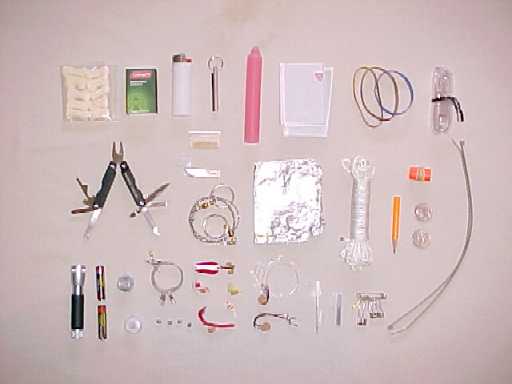Multi-Purpose/Miscellaneous Group


This is the bulk of the large Personal Survival Kit's contents that enables you to make fire, fix or improvise things, get food and cook it.
The top row is mostly fire-making items: Tinder Quick waterproof tinder, which will light from either a spark or flame; waterproof matches and a cigarette lighter, for two quick ways to start fire; a flint and magnesium sparking stick, to light the Tinder Quick; and a candle, to start a fire, or for heat and light in a shelter.
The sparking stick can also be used to signal at night, by running the file blade from the multi-tool along it to throw out a brilliant trail of sparks that can have almost a strobe-like effect if done every few seconds.
The middle row is most of the tools: a 12-implement multi-tool, that includes a knife blade, screwdrivers, awl, nail file, bottle opener, pliers, etc.; a single-edged razor blade and 2 razorknife blades, for cutting, first aid, food preparation, and as backups to the knife; a wire saw for heavy-duty shelter construction, firewood cutting, even game preparation since it's supposed to saw bone, too.
There is aluminum foil for making cooking pots to boil water, cook food, or stretched out flat for signaling; more than 3 feet of duct tape in 10.5-inch strips (if it can't be fixed with duct tape, it can't be fixed); nylon cord for shelter building; a flashlight with 2 AAA batteries, which are stored outside the flashlight in case they leak; fishing hooks, line, sinkers, lures and leaders to try and get food that way; needles for first aid or equipment repair using the fishing line or dental floss; safety pins for clothing repairs, fishing or repairing other things; orange flagging to mark snare locations, trails, your camp or for signaling; a pencil for messages and quarters for phone calls (the irony of finding a pay phone in a remote spot and not having any change would be too much to bear); plastic tubing to get water from seeps or a solar still; cable ties for repairs or an emergency tourniquet; and rubber bands for a slingshot or gear repairs.
Some might argue that the fishing kit is too minimal to do any good, but I have to take several factors into account: 1) I'm not a fisherman, 2) Since I travel a lot, I have to pick things that will work in a variety of habitats, 3) I can always use the fishing line for other things, like gear repairs. Talking with people who do fish a lot enabled me to make an informed decision about what types of lures would work in the greatest number of habitats. I should probably add more hooks, though, since I was assured that I would lose most of them, no matter what the situation!
A final note about storage. Things that
might melt if they get hot, like the candle, or dissolve if they get wet, like
the matches and striker strip, are put in small plastic bags, preferably the
Ziploc type (their 'snack size' bag, at 6 1/2 x 3 1/4 inches, is a good size for
small item storage) that you can get at the grocery store or a jeweler's.
ALL PHOTOS AND TEXT © COPYRIGHT 2003 BY THE
AUTHOR. ALL RIGHTS RESERVED. REPRODUCTION, RETRIEVAL OR STORAGE BY ANY
METHOD FOR ANY COMMERCIAL PURPOSE IS PROHIBITED. SEND COMMENTS HERE.
Return to Personal Survival Kits
This page was last updated Dec. 10, 2003
